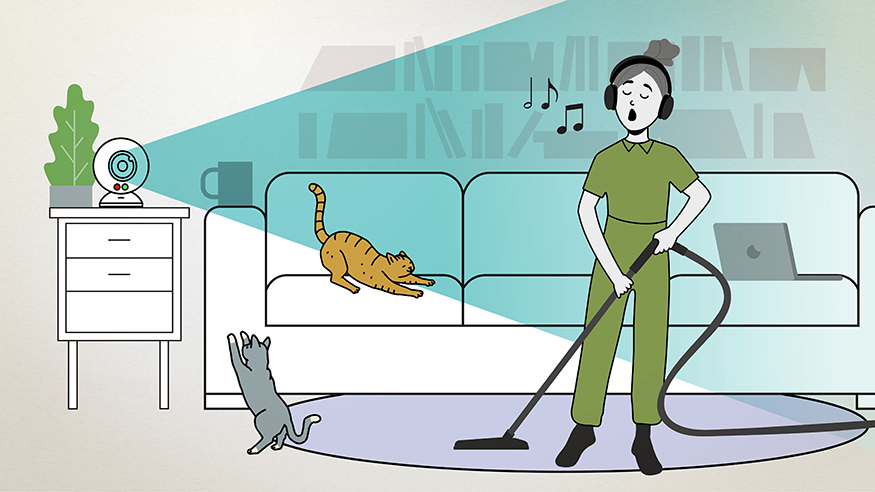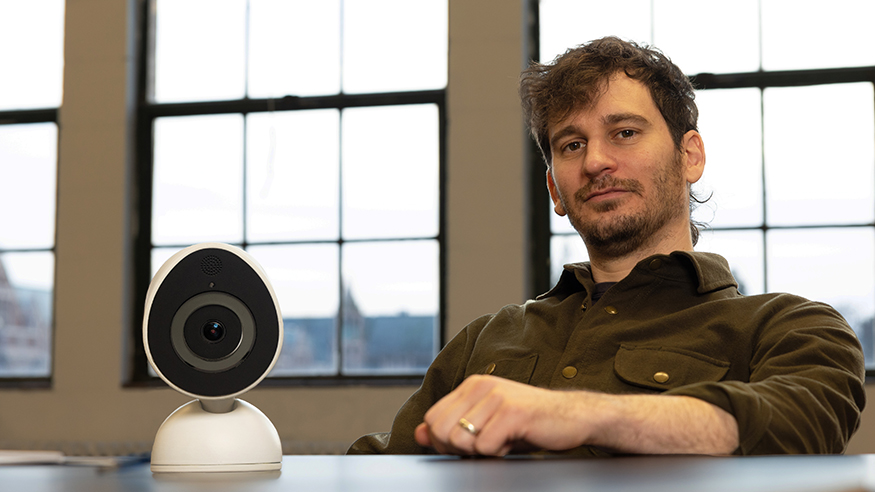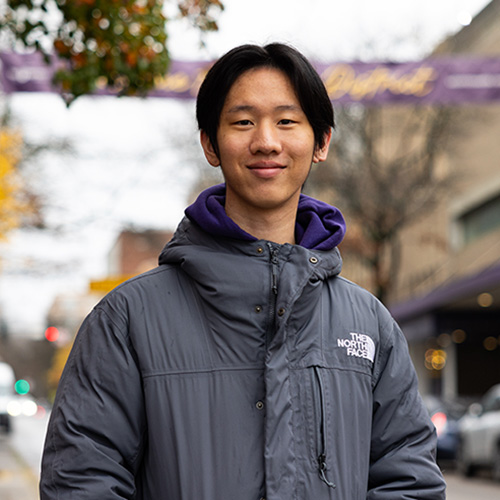
Imagine your neighbor asks you to cat-sit her beloved tabby for a week. Each day, you provide fresh food and water and a warm lap for the cat. While you’re there, you also peruse the neighbor’s bookshelf, examine her framed family photos, and investigate her eclectic collection of hundreds of ceramic felines. “Her cat collection is ridiculous!” you laugh on the phone to a friend while the cat purrs in your lap. “It’s sad, really.”
And then you notice the neighbor’s home security camera pointed right at you.
You might be embarrassed. You might be angered by the breach of privacy. But you should not be shocked. A growing number of people have surveillance cameras inside or outside their home for all sorts of reasons. How such surveillance impacts others who spend time in the house — pet sitters, nannies, housecleaners, visiting family members — is a focus of James Pierce’s current research.
Pierce, associate professor of interaction design in the UW’s School of Art + Art History + Design (SoA+AH+D), has been awarded two National Science Foundation (NSF) research grants to support this work, with undergraduate and graduate students included as members of his research team.
“The funding has been recognition that design can have an impact and is valued by the National Science Foundation,” Pierce says. “And with that NSF support, we’ve been able to include students in this work who usually wouldn’t have this opportunity in a design or arts program.”
Diverse Reactions to Home Surveillance
The field of interaction design developed to address how people interact with computers. Pierce’s training for this work includes a PhD in human-computer interaction (HCI) and a bachelor’s degree in applied mathematics, with a minor in computer science. His interest in home security devices dates back to a news story he read in 2016 about the “new social etiquette” around surveillance devices in and around the home.

The story debated whether workers and guests spending time in the home could ask the homeowner to temporarily turn off their devices, and if so, how to raise the issue. Pierce was intrigued by the experience of people impacted by such devices.
“In the areas of design I work in, we’re always talking about user-centered design,” says Pierce. “It’s all about how to make things easy and helpful for the user. But here was a clear example where the concept of optimizing for the user didn’t work because you have this other person in the equation. Are they also a user? Not a user? They’re in the house but they don’t own the device.”
To explore that question, Pierce has studied a range of “adjacent users” — people who engage with or are affected by interactive technologies but may have little or no direct awareness of the devices and no consent or control over their use. He has interviewed domestic workers and other adjacent users to better understand the power dynamics and trust issues that a surveillance camera and microphone might raise.
Uncomfortable with the privacy implications of the devices when he began the project about five years ago, Pierce assumed others would feel the same. Some of their responses surprised him.
I try to look at a problem that everyone’s been working on and discover a different way of seeing it. I think that’s where the artist in me comes out.
There were adjacent users who viewed the presence of such devices as a significant breach of privacy, trust, and respect, but many others weren’t overly concerned with cameras or with being caught doing something improper. Yet even among the latter group, some admitted to changing behaviors because of the camera. A nanny, after insisting the camera didn’t bother her, shared that she checked notifications on her Apple watch rather than her cellphone because the employer might consider checking her phone a red flag.
“There were a lot of examples like that, where people would say they didn’t mind the camera but then changed their behaviors to conform to this new environment of surveillance,” says Pierce.
A more consistent complaint was not being informed that a camera was being used, though the level of concern varied. Those who’d already established trust with the owner often assumed the owner simply forgot to mention the camera. But some domestic workers quit after learning that a camera had been installed, viewing it as a sign of the employer’s lack of trust in them.
“While we notice some patterns emerge in these conversations, there’s quite a bit of variance, which tells us that it will be really hard to come up with a slam-dunk solution that meets everyone’s needs,” says Pierce.
Short-term Solutions, Long-term Questions
While there might be no perfect solution, Pierce has been designing and testing new features for home devices to potentially mitigate pressing concerns. Some solutions are deceptively simple, such as making the camera and its recording status more obvious, since many camera owners assume people are aware of the smart device when they are not. Other solutions include a set of features that owners can use to get information — and peace of mind — from the camera while still offering privacy protections for the people around them. Recently, Pierce has been working with UW’s CoMotion to file a provisional patent on these innovations.
“I try to look at a problem that everyone’s been working on and discover a different way of seeing it,” Pierce says of his approach to research. “I think that’s where the artist in me comes out. I might look at something in a way that seems stupid at first, but then I just really dig into it and often something useful comes out of it.”
Pierce can’t share specifics of the project since the team is pursuing an intellectual property (IP) patent, but he’s quick to note that improving user interfaces is just one aspect of his research. At heart, he is a futurist focusing on where technology is headed in five or ten years.
“We know these are only partial solutions,” he says of current products in development. “These problems with trust and control and privacy are going to persist. What we’re doing is trying to pinpoint very specific things where we might be able to push the needle a little bit. We’re also hoping to use these prototypes as a prompt for discussion, to get people talking about some of the things that may require policy legislation to actually change.”
As for his own stance on smart devices for the home, Pierce admits to an evolution in his thinking. Five or six years ago, the idea of a camera inside the home horrified him. Now he sets one up before leaving town so he can virtually visit his cat. To give his cat sitters privacy, he places a rag next to the camera and offers them the option of covering the camera during their visit.
“Half the people take me up on it and half act as if they don’t mind the camera,” Pierce says. “That all tracks with the situation we’re in with a lot of these devices. Things are always evolving, and the best we can do is try to adapt. That’s what people have always done with technology. In that sense, this is nothing new.”
More Stories

A Healing Heart Returns
In February, the UW Symphony will perform a symphony that Coast Salish elder Vi Hilbert commissioned years ago to heal the world after the heartbreak of 9/11. The symphony was first performed by the Seattle Symphony in 2006.

The Public Impact of Private Cities
Geography major Edwin Bai has researched private cities, developed by individuals and corporations, that "take the libertarian idea of low government regulation to the maximum."

Coast Salish Traditions are "Woven in Wool" at the Burke
A Burke Museum exhibit, co-curated by Coast Salish weavers and Burke curators, highlights the importance of weaving to Coast Salish communities.
